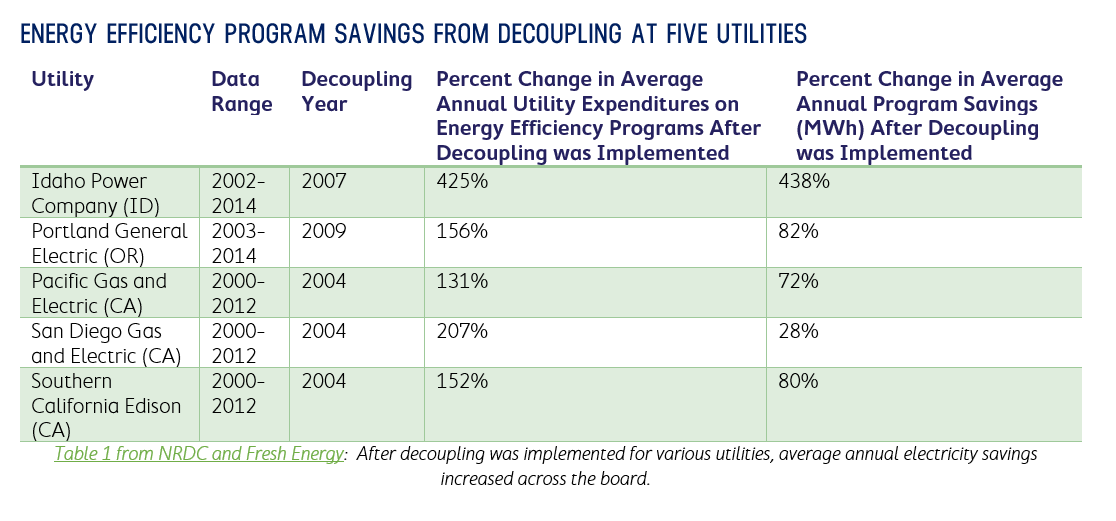Dissolving Utility Barriers to Energy Efficiency: Decoupling and Performance-based Regulation
Due to decreased revenues and a widespread demand for energy efficiency, some utilities and state regulatory bodies have shifted away from traditional utility business models. Electricity demand over the last decade has been flat, reflecting an increase in energy productivity. Additionally, COVID-19 has caused anomalies in electricity demand, including decreases in commercial buildings’ energy use and increases in residential energy use. In many states, unpredictable demand can destabilize utilities’ finances, forcing them to ask state regulators for rate increases.
Decoupling and performance-based regulation (PBR) are two strategies to incentivize energy efficiency. Executed properly, they can improve the long-term financial solvency of utilities while helping them meet increasingly aggressive efficiency and decarbonization goals.
HOW DOES DECOUPLING PROFITS FROM ELECTRICITY SALES AFFECT UTILITIES AND CONSUMERS?
As of 2019, 35 states have decoupling in place for electricity or natural gas at one or more major utilities; 11 of those states have decoupling for both.
In states with decoupled utilities, PUCs and utilities agree on a reasonable amount of fixed revenue for the utility based on revenue from previous years, as well as upcoming utility service area needs, and then allow rates to change with electricity consumption to meet the fixed revenue target. Despite concerns that this could lead to higher electricity rates, in practice, decoupling typically has little impact on rates. Almost three quarters of rate adjustments made under decoupling lead to no more than a 3% increase or decrease in rates. Table 1 below illustrates examples of utility expenditures on energy efficiency and utility energy savings after decoupling.
What is decoupling-plus? Rather than utilities getting paid for how much electricity or gas households and businesses consume (traditional system), or getting paid at a fixed rate set by state commissions (decoupled system), in the “decoupling-plus” system utilities get paid for how much electricity or gas they successfully help consumers save. California adopted a “decoupling-plus” policy in 2007, which intends to incentivize efficiency investments so they are more profitable than a new power station. In California, the California Public Utilities Commission (CPUC) compares the energy savings from efficiency investments to the cost of new power plants. The more efficient a utility is and the more successful they are at exceeding the Commission’s target, the more profit they will make, up to a certain threshold.
In short, a traditional system disincentives efficiency, a decoupled system allows efficiency to compete on a level playing field with other energy sources, and a “decoupled-plus” system directly incentivizes efficiency.
WHAT IS PERFORMANCE-BASED REGULATION (PBR)?
PBR is an alternative to traditional cost-of-service (COS) regulation.
Setting clear definitions of goalsIn 2019, 28 states offered a performance incentive for at least one major electric utility, and 17 states have incentives for at least one major natural gas utility. While PBR can have positive implications for efficiency, state regulators should take precautions around establishing goals, including:
- Considering the long-term predictability of goals to encourage appropriate utility investment
- Planning for consistent evaluation of the PBR, and modification to goals and metrics as necessary
- Accounting for the unique needs, goals, and vulnerabilities of the jurisdiction
Example of performance-based regulation in Illinois: In 2011, the state passed the Energy Infrastructure Modernization Act, which created performance incentive mechanisms (PIMs) that boosted utility revenues when they met electricity reliability benchmarks. Thanks to this ratemaking formula, 11 million customer outages have been avoided in the last six years and the utility requested a rate decrease four years in a row.
The 2016 Future Energy Jobs Act added reward and penalty PIMs for energy efficiency programs. Since this legislation passed, efficiency is reportedly integrated heavily into utility culture.
TAKEAWAYS
Traditional COS regulation, particularly when electricity or natural gas profits are coupled with the volume of energy consumed, is an inherent disincentive for efficiency. States that have not decoupled their electric and natural gas utilities are not letting efficiency compete on a level playing field with other energy sources.
Furthermore, addressing the threat of climate change requires energy efficiency to be dramatically ramped up. For this reason, state regulators should consider innovative policies that fully value energy efficiency and incentivize its scale-up.



